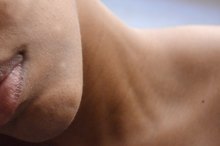Pros and Cons of Tanning Beds
Many people, especially those with lighter complexions, prefer to have tans because they want to look more radiant with darker skin tones. A tanning bed--which emits ultraviolet (UV) radiation--is used to achieve a well-tanned complexion. If you are thinking of using tanning beds, some pros and cons are worth nothing. Find out how one outweighs the other, and if the risks are worth taking.
Many people, especially those with lighter complexions, prefer to have tans because they want to look more radiant with darker skin tones. A tanning bed--which emits ultraviolet (UV) radiation--is used to achieve a well-tanned complexion. If you are thinking of using tanning beds, some pros and cons are worth nothing. Find out how one outweighs the other, and if the risks are worth taking.
Even Tan On-Demand
How to Stop Skin From Getting Darker From the Sun
Learn More
One of the advantages of tanning beds is that you do not have to wait for a warm, sunny day to get your tan. You can get a tan at any time of the day and during any type of weather. If you need a tan to look great for a party, you can have your tan done that same day.
Trained tanning professionals can assist you in achieving an even tan. You will not have patchy or blotchy spots because the UV settings will be the same for each area. This is not always possible when tanning outdoors because the intensity of the sun's UV differs at different times of the day and at different weather conditions. What this means is that you cannot control the sun, but you can control a tanning bed.
- One of the advantages of tanning beds is that you do not have to wait for a warm, sunny day to get your tan.
- This is not always possible when tanning outdoors because the intensity of the sun's UV differs at different times of the day and at different weather conditions.
Treating Psoriasis
According to the National Psoriasis Foundation, most practicing dermatologists discourage patients with psoriasis (a medical condition that occurs when skin cells grow too quickly) from using tanning beds; however, some view this method as a last resort if patients do not have access to light therapy. Consult your doctor if you are considering tanning beds for treating psoriasis.
Vitamin D
Tanning Beds and Acne
Learn More
Nicknamed the "sunshine vitamin," vitamin D helps maintain normal blood levels of calcium and phosphorus. It also helps in the absorption of calcium. Without vitamin D, bones can become thin, brittle, soft or misshapen. Exposing the body's surface to either direct sunlight or tanning bed radiation is effective in increasing blood concentrations of Vitamin D, according to a study by Vanderbilt University.
- Nicknamed the "sunshine vitamin," vitamin D helps maintain normal blood levels of calcium and phosphorus.
Melanoma
Melanoma is the most lethal form of skin cancer and is highly prevalent among women aged 25 to 29 years old. In the U.S. alone, according to the American Cancer Society, this form of cancer is second only to breast cancer. Tanning beds use UV radiation, which can cause melanoma. A study published by the British Journal of Cancer showed significantly elevated odds ratio for developing malignant melanoma after regular exposure to tanning beds.
- Melanoma is the most lethal form of skin cancer and is highly prevalent among women aged 25 to 29 years old.
Side Effects
Tanning beds may cause itching, skin rashes and nausea. Frequent exposure to UV radiation can also cause premature skin wrinkling.
Risks of Overexposure to UV
Only trained or certified individuals and operators should operate tanning beds; however, not all states have strict regulations. According to the National Institutes of Health, in all, 55 percent of the 50 states and the District of Columbia had indoor tanning laws, and 41 percent had laws addressing minors' access. A study published by the Journal of the American Academy of Dermatology showed that at least 70 percent of surveyed tanning operators have received little or no formal training at all in the use of tanning beds. Most are unaware of contraindications to tanning side effects, and have little knowledge of how to administer first aid treatment in case of emergencies. Wrong UV dosage or overexposure can occur, leading to skin burns when the operator is not familiar with skin types and conditions.
- Only trained or certified individuals and operators should operate tanning beds; however, not all states have strict regulations.
Related Articles
References
- Journal of American Osteopathic Association: Sun Exposure, Tanning Beds and Vitamin D Levels
- Food and Drug Administration: Indoor Tanning--The Risks of Ultraviolet Rays
- American Association for Cancer Research: Tanning Beds, Sunlamps, and Risk of Cutaneous Malignant Melanoma
- Vanderbilt University: Tanning Beds and Vitamin D
- World Health Organization: Sunbeds, Tanning and UV Exposures
- Scarlett WL. Ultraviolet radiation: sun exposure, tanning beds, and vitamin D levels. What you need to know and how to decrease the risk of skin cancer. J Am Osteopath Assoc. 2003;103(8):371-5.
- Le clair MZ, Cockburn MG. Tanning bed use and melanoma: Establishing risk and improving prevention interventions. Prev Med Rep. 2016;3:139-44. doi:10.1016/j.pmedr.2015.11.016
- Reimann J, Mcwhirter JE, Papadopoulos A, Dewey C. A systematic review of compliance with indoor tanning legislation. BMC Public Health. 2018;18(1):1096. doi:10.1186/s12889-018-5994-4
- Brouse CH, Basch CE, Neugut AI. Warning signs observed in tanning salons in New York City: implications for skin cancer prevention. Prev Chronic Dis. 2011;8(4):A88.
- Sivamani RK, Crane LA, Dellavalle RP. The benefits and risks of ultraviolet tanning and its alternatives: the role of prudent sun exposure. Dermatol Clin. 2009;27(2):149-54, vi. doi:10.1016/j.det.2008.11.008
- American Academy of Dermatology. Skin Cancer: Incident Rates. 2017.
- American Academy of Dermatology. Prevent Skin Cancer. 2017.
- Bauer A. 10 Tips for Protecting Your Skin From the Sun. American Society of Clinical Oncology. 2015.
- World Health Organization. Restricting the Use of Sunbeds to Prevent Skin Cancer. Bulletin of the World Health Organization. 2017;95:798–199. doi: 10.2471/BLT.17.021217.
Resources
- National Women's Health Report: Women Skin Health
- National Institutes of Health: Measuring the Stringency of States' Indoor Tanning Regulations
- National Psoriasis Foundation: Treating Psoriasis
- British Journal of Cancer: Risk of Cutaneous Malignant Melanoma in Relation to Use of Sunbeds
- Journal of the American Academy of Dermatology, Volume 29, Issue 6, Pages 959-962, V. Mawn, A. Fleischer Jr.
Writer Bio
Josienita Borlongan is a full-time lead web systems engineer and a writer. She writes for Business.com, OnTarget.com and various other websites. She is a Microsoft-certified systems engineer and a Cisco-certified network associate. She graduated with a Bachelor of Science in medical technology from Saint Louis University, Philippines.









